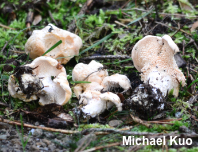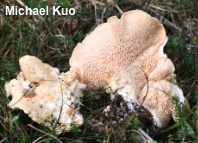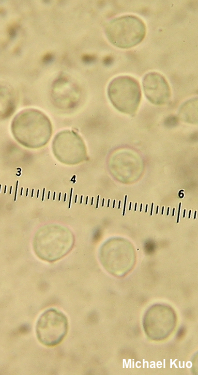| Major Groups > Toothed Mushrooms > Hydnum > Hydnum repandum |

|
Hydnum repandum [ Basidiomycota > Cantharellales > Hydnaceae > Hydnum ... ] by Michael Kuo First described by Linnaeus in 1753, Hydnum repandum is a European species associated with various trees, including spruce and beech. Like other species of Hydnum it features soft spines on the underside of the cap and soft, white flesh. Separating Hydnum repandum from other Hydnum species can be a challenge, but the fairly large size, pale colors, non- or weakly staining surfaces, and almost round spores about 8 µm long are the important determiners. Similar species in Europe include Hydnum magnorufescens, with strongly bruising surfaces—and several species with darker cap colors, including Hydnum rufescens (slender, yellow-orange) and Hydnum ellipsosporum (dark orange, flattened spines, ellipsoid spores). By current, DNA-informed definitions Hydnum repandum does not occur in North America, although the name has traditionally been used in North American field guides. Hydnum washingtonianum, associated with conifers and known so far from Newfoundland and Labrador, Washington, and California, is morphologically very similar and very closely related to Hydnum repandum, as is eastern North America's hardwood-associated Hydnum subolympicum. Other similar species in North America include Hydnum subtilior (smaller and often paler) and Hydnum aerostatisporum (larger, darker orange). Description: Ecology: Mycorrhizal with hardwoods or conifers, especially spruces and beech; growing gregariously on the ground; summer and fall; widely distributed in Europe. The illustrated and described collection is from northern Italy. Cap: 6–15 cm wide; broadly convex, becoming planoconvex or flat; the margin inrolled at first, becoming wavy and broadly scalloped; dry; bald; becoming finely pocked; pale orange to nearly white. Undersurface: Usually just beginning to run down the stem; covered with densely packed, soft spines that are round in cross-section and measure 2–5 mm long; creamy to very pale orange; not bruising. Stem: 3–6 cm long; 1–2.5 cm thick; sometimes somewhat off-center; dry; smooth; whitish; not bruising. Flesh: Whitish; unchanging when sliced. Odor and Taste: Sweetish, not distinctive. Microscopic Features: Spores 6–8 x 5.5–7 µm; subglobose to broadly ellipsoid; smooth; hyaline in KOH. Basidia 4-sterigmate; 29–34 x 5–6 µm; subclavate. Pseudocystidia 30–40 x 3–8 µm; mostly cylindric with rounded apices, but occasionally irregular or sublageniform; thin-walled; smooth; hyaline in KOH. Pileipellis not clearly differentiated; cap surface hyphae tangled, 2–6 µm wide, hyaline to ochraceous in KOH, with clamp connections. REFERENCES: Linnaeus, 1753. (Fries, 1821; Phillips, 1981; Breitenbach & Kränzlin, 1986; Persson, 1997; Kibby, 2006; Buczacki et al., 2012; Olariaga et al., 2012; Vizzini et al., 2013; Feng et al., 2016; Gminder & Böhning, 2017; Niskanen et al., 2018; Læssøe & Petersen, 2019.) Herb. Kuo 10111407. This site contains no information about the edibility or toxicity of mushrooms. |
© MushroomExpert.Com |
|
Cite this page as: Kuo, M. (2020, September). Hydnum repandum. Retrieved from the MushroomExpert.Com Web site: http://www.mushroomexpert.com/hydnum_repandum.html |


